Burlesque Part II:
Famous Dancers of the Burlesque Stage,
& Chinese Joy Dance
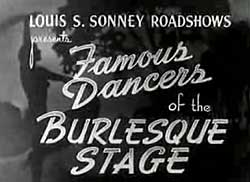 A one-reel compilation of short-short burlesque films bills itself "Louis S. Sonney Roadshows presents" Famous Dancers of the Burlesque Stage (c1950).
A one-reel compilation of short-short burlesque films bills itself "Louis S. Sonney Roadshows presents" Famous Dancers of the Burlesque Stage (c1950).
It gathers eight films in the one & a half minute to two & a half minute range, filmed at different times & different places, some of them evidently of obscure or otherwise unknown dancers hired by Louis S. Sonney, who ran a travelling couchie-couchie show with a small carnival that travelled in the Pacific Northwest in in the 1930s & 1940s.
It was no doubt a benefit to him to have close personal connections with the police, who'd be less inclined to crack down on his travelling roadshow or carnival midway burlesque gals.
Louis S. Sonney had been a police officer from Centralia, Washington. He gained national fame in 1921 when he captured a notorious train robber, Roy Gardener, famed as "the smiling bandit."
Bankrolling himself with a reward of $5,000 dollars he quit police work & began at the bottom, so to speak, in the entertainment industry. Burlesque houses were generally in the oldest & run-down theaters that became too hot to use in July & August, so would close down until September. In summer they needed a roadshow manager, & some of the girls would go from town to touch working in the courch tent.
That was Louis's ingress to the entertainment world. And it was these women who were photographed either from the third to seventh row of a burlesque house, or in some cases on tiny midway stages. These films, along with postcards, were sold in the 1930s as 16 mm home projection movies, or were projected in adult bookstore backrooms. Then in the 1940s production of such under-three-minute films increased, to be shown on panoram visual jukeboxes in a continuous loop of four to eight short-short strip acts.
The panoram phenomenon for above-board musical performances ended in 1947, but their use as peepshow boxes persisted into the 1960s, with lots of b/w vintage burlesques or newer, color nudie-cutie shorts entirely supplanting music films. No new panorams were being built, no new film footage for music being shot, but there were plenty of machines transferable to the peepshow trade after they became dead weight for the bars, bus stations, & cafes that used them to show 1940s musical stars.
The compilation loops was probably done very early in the 1950s by Louis S. Sonney's son Don, who built his father's small underground business into a successful softcore sexploitation film industry, & who bought up old film footage to recycle to grindhouses or the last of the burlesque houses which showed short films between live acts in the early '50s, nudie-cutie & burlesque films not supplanting live acts altogether until about 1956.
Some of the films may have been produced or directed by Don Sonney himself, although the two-minute pieces are in the main of a similar style & type made by many directors in many towns, especially on the two coasts & in Chicago, trading hands without copyright protection.
The eye behind the cameras may rarely have wanted credit, but there's no question that some of the women in front of those cameras were proud of their occupation. The stripper memoires that have come down to us are marvels of self-examination, cultural reflection, & pride in an artform.
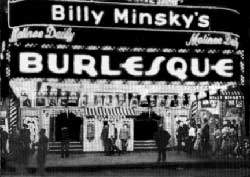 And modern condemnatory assumptions about burlesque houses tend to be entirely wrong, as they were respectable ways to experience a night out without the kids for married couples & groups of women as well as for men, & the image of dancing for shiny-pated vulgar old gents exclusively is false.
And modern condemnatory assumptions about burlesque houses tend to be entirely wrong, as they were respectable ways to experience a night out without the kids for married couples & groups of women as well as for men, & the image of dancing for shiny-pated vulgar old gents exclusively is false.
The live shows also featured skits & baggy-pants clowns & there was always the "talking woman" who never danced but would do either stand-up comedy or serve as foil to the emcee (usually himself a singer & comic) or the baggy-pants clown.
These theaters of the '40s & '50s were links to entertainment to both the carnival midways & the great vaudeville theaters that predated radio & television, & while there were indeed women who declined under the horrors of drug abuse, alcoholism, & prostitution, such was by no means inevitable. As other women signed 40-week contracts earning a thousand dollars a week or more, & were stars in their own right plying a trade, expressing an artform, & raking in the bucks.
Vaudeville/burlesque may have begun to decay with the advent of cinema, radio, & television which put all but the most circumspect aspects of vaudeville out of business, but even so, it was show business!
ss stage performers, many of the women may have felt or been exploited & had miserable lives, & most who are glimpsed in vintage footage of this sort had no reputations with very little about them surviving in the public record. But others were national odelisks no less than todays Paris Hiltons & other red-carpet striders or music-video dancer-singers like Jennifer Lopez or Britney Spears or even a Jessica Alba, running the gamut of morality & talent from lots to very little.
For many performers, burlesque was not just the dregs of an expired vaudeville. It was family & friendships & entertainment, with a rich & vital history going back at least to the ragtime era. Burlesque vaunted in its own mileau, despised only by outsiders.
The films were shown individually or in groups on a looped reel in adult magazine shops & movie houses, carnival tents, or sold as 8 mm & 16 mm films for stag parties or home viewing, generally grouped in small selections as one-reelers.
These films survive as intriguing & sometimes beautiful records of entertainment's least respected folkways, preserving the talents alongside the near-talents of women who were objectified, idolized, stigmatized, envied, arrested, feted, deplored, & adored. And contrary to popular opinion, many loved themselves & their artform, & strove to create illusions of beauty & sensuality.
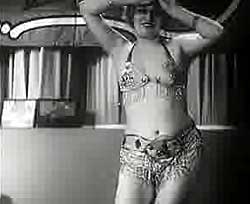 Famous Dancers of the Burlesque Stage as a spliced collection of short-shorts starts out with a film reenaccting an historical couchie dancer, separately titled Burlesque Cutie of the Gay Nineties, subtitled rudely "They Called Her Fatima. Or was it Fat Emma?"
Famous Dancers of the Burlesque Stage as a spliced collection of short-shorts starts out with a film reenaccting an historical couchie dancer, separately titled Burlesque Cutie of the Gay Nineties, subtitled rudely "They Called Her Fatima. Or was it Fat Emma?"
The shapely dancer is by no means fat, though she does have Mae West's face. She's wearing a fringed bikini-type outfit as she does some mild shimmying, presumedly in imitation of the original Fatima who first gained fame at the 1893 Columbia World's Exposition in Chicago & was later a star of the Coney Island night-time adult arcade.
The original Fatima was a woman celebrated in a handful of short films from the turn of the century, including Fatima's Couchee-Couchee Dance (1896). Her 1930s or '40s imitator probably reflect some of Louis Sonney's carnie patter, as he bragged of burlesque's pedigrees, but also reflected burlesque's awareness of its own history.
One authentic part of this performance is that it is of a type that would not tire our neo-Fatima if it had to be sustained over a long time. In the Edwardian era if you were a cooch dancer at Cony Island or some other carnival midway, you might have to dance for hours at a time, so you learned to be just a little bit sexy & not use up your energy for the long haul.
The stage is barely shown by the stationary camera, which is too bad, as from what little is glimpsed, it seems to have been tricked out to look like an old carny stage, exactly where all-day exotic dancing would've been performed in this slow untiring manner. Possibly, though it's impossible to know, this may be a real carnie coochie stage, the very one carted from town to town by Louis S. Sonney.
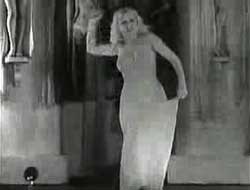 The second short-short on the reel is Today We Have Ginger Britton with the subtitle "Did we say Ginger? What do you think?"
The second short-short on the reel is Today We Have Ginger Britton with the subtitle "Did we say Ginger? What do you think?"
This dancer wants to project the possibility that she was influenced by Ginger Rogers, whose general appearance in 1930s Hollywood films she's emulating, the while mixing some of Ginger Rogers' signature dance poses with striptease moves.
Set on an enormous & well decorated burlesque stage in the "follies" tradition, this one's could've been filmed on any one of a large number of burlesque houses across the nation, but given the size of the stage & stage decorations, it's a leading theater of its kind.
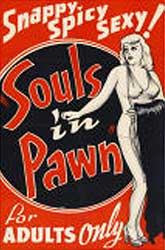 Ginger Britton struts around with enough clothes on to appease a Muslim cleric, but immediately sheds one layer. Other girls stand in semi-undress or behind gauzy cloth on the top of pedistals & a staircase, but don't much move. Ginger Britton struts around with enough clothes on to appease a Muslim cleric, but immediately sheds one layer. Other girls stand in semi-undress or behind gauzy cloth on the top of pedistals & a staircase, but don't much move.
In light long garment she leaps & poses quite nicely. The long garment drops from the shoulders to waist & she continues dancing topless. Then the overgarment comes of completely & she's dancing about in her high heels & blonde wig.
The faded & worn quality of the film is so poor I can't tell if there's a body sock, but probably there is, or at least flesh-colored pasties & g-string. At times it looks more like she's doing a cheerleading routine without her clothes. She's cute but not much of a dancer.
Ginger Britton was never terribly famous, but she almost became a film star. At least, she appears in a grindhouse sexploitation film Souls in Pawn (1940) about a girl pregnant out of wedlock, abandoned by her lover, abused by an evil doctor in an abusive home for wayward girls, & ends up selling her baby to become a stripper.
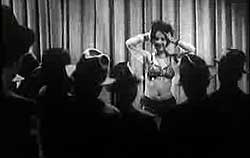 The reel's third film has very much the look of a "soundie" & again the right length to be viewed in an adults-only panoram visual jukebox. The reel's third film has very much the look of a "soundie" & again the right length to be viewed in an adults-only panoram visual jukebox.
Carlotta: A Hot Tamale from South of the Border is subtitled "Viva la May-Hee-Co!" Standing on a bland stage & shimmying up a storm against a large curtain, horny guys obscure her presence; they're all wearing the same style of rumpled fedora hats.
The men vanish when the camera jump-cuts for a closer view, but we'll see the camera shot from further back in the "seats" soon enough.
The vast majority of this type of panoram movie were shot from a few seats back in theaters, but it was novel to show an actual audience, & this purported audience is obviously trumped up by the filmmaker & arranged to leave a clear view of the stripper.
She's not especially talented, but has a fit body & reflects the usual level of talent of the many burlesque women as opposed to the elect of the trade. Even though many of these women did have a definite talent that lent them regional or national fame, that wouldn't've been the majority. And it's interesting to see the "average" as well as the exceptional.
The phrase "red hot tamale from south of the border" was a cliche of burlesque emcee patter typically reserved for redheads with Latin American costume if not actual Latinas.
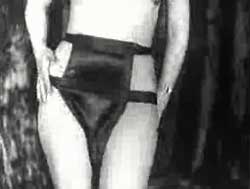 Filmette four is Lovely Rene the Toast of Paris subtitled "Streamlined & Rarin' to Go. Ooh-la-la!" All these subtitles descend from carnival barker & burlesque house emcee introductory patter.
Filmette four is Lovely Rene the Toast of Paris subtitled "Streamlined & Rarin' to Go. Ooh-la-la!" All these subtitles descend from carnival barker & burlesque house emcee introductory patter.
The chances of her having actually been a feted Parisian dancer aren't great, but every burly-q needed a hook or gimmick.
Like Carlotta, Lovely Rene hasn't a great deal of actual dance talent, but she's got a body worth braggnig about, & a skimpy outfit that threatens to show too much.
She struts & humps across a stage in front of a shiny curtain, throwing her hands about like she's slapping a pony. She then makes like she's splashing herself with water.
It's completely amateur night, so the camera pans in close to try to see under the flopping piece of cloth half-hiding her butt.
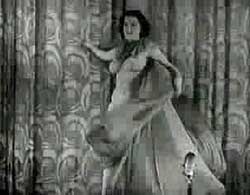 These films have not been outstanding apart from their intended usefulness in their day, & up to this point only Ginger Britton seems to have reflected a higher grade of staging & presentation.
These films have not been outstanding apart from their intended usefulness in their day, & up to this point only Ginger Britton seems to have reflected a higher grade of staging & presentation.
Fifth on the reel preserves the level by now expected. Bonnie Jean Hendrie has the old-joke subtitle "Hasn't She The Most Beautiful --" then the word "Eyes" materializes in the blank space, hardy har.
This is another crappy dancer who doesn't overcome the pathos of making one's living by doing dog-paddle motions across a stage in front of a musty dusty curtain. Not all such gals can represent glamour; but there'd always be certain audience members who preferred dirty pathos.
She's wearing a Supergirl cape & skin-colored bikini. She'll remove all this before it's over, but will even then have a g-string covering for the important bits, keeping it legal.
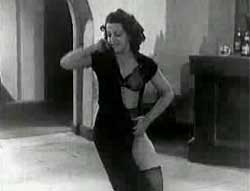 Exotic Rose la Rose has the subtitle "Tops in any league." Miss La Rose was very well known throughout the continent as "the original TNT girl," & really was tops in her league.
Exotic Rose la Rose has the subtitle "Tops in any league." Miss La Rose was very well known throughout the continent as "the original TNT girl," & really was tops in her league.
In this short stag film or midway loop, a "scene" is presented of a young woman, perhaps a drunken housewife, in a bar, dancing by herself.
It deserves a couple points for originality & the dramatic sadness of it all. La Rose begins to take off her dress revealing fancy under things. She's not exactly a good dancer, but she "in character" playing a tipsy barfly, so is intentionally a little skewed in the reenactment.
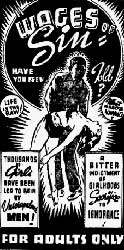 It concludes with her showing her breasts full front, so the customers sure wouldn't be complaining, given that so many such films did the tease only, not the reveal. It concludes with her showing her breasts full front, so the customers sure wouldn't be complaining, given that so many such films did the tease only, not the reveal.
Rose la Rose was a performer at Minsky's along with Gypsy Rose Lee. Miss La Rose has an uncredited role as a stripper in the Herman E. Webbe directed The Wages of Sin (1938) about an impoverished young woman forced into prostitution, with a cameo for sexploitation mini-mogul Louis S. Sonney.
She also has a supporting role in Sam Newfield's Queen of Burlesque (1946), which includes a murder mystery involving lesbianism.
When asked why she got in the business, La Rose said, "I didn't want to stand behind a counter & serve people." She eventually owned a veritable chain of burlesque theaters in Toledo, Ohio, & made extra on the side teaching housewives how to strip for their husbands.
She became (according to Walter Winchell) the highest paid stripper in America. A typical act would be her singing of a song called "Who Will Kiss My Oo La La?" & she'd dance frequently slapping her "oo la la" fanny.
Rose la Rose also brought about the final death-blow to live burlesque. The burlesque houses she owned in Toledo were the first to switch entirely to "nudie cutie" feature films, so that she no longer had to deal with the egos of burlesque queens & comics & drunken musicians & stage hands.
It was a matter or months after her switch-over before other burlesque theaters across the country began making the switch, being already set up to show films between live acts, so having no new investment requirements to quite suddenly do away with the live portion of the daily entertainment.
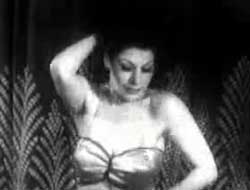 Anette Naughty Naughty is the penultimate short-short, with the subtitle "And Doesn't She Work Hard?" That's a lame joke which accurately reflects the level of "bawdy" humor of the era, which tended to be mere double entendre & not really all that vulgar.
Anette Naughty Naughty is the penultimate short-short, with the subtitle "And Doesn't She Work Hard?" That's a lame joke which accurately reflects the level of "bawdy" humor of the era, which tended to be mere double entendre & not really all that vulgar.
She steps through a curtain in evening gown & begins to do quite a good jazz-era dance mixed a bit with rhumba. She's a real talent, & from what can be made out with old worn-out film footage, a beauty to boot.
She has speeded up her act to get the stripping part done brief time alotted on such films, but if she could do her actual show with better pacing, she'd probably be pretty damned exciting both as a dancer & as a tease.
Throughout the pealing she keeps doing damned good dance moves. By the end she's wearing only a flesh-colored bikini bottom string-thin in the back.
She seems too good at this to just be one of the thousand also-rans of burlesque, but I couldn't find more information about any "Anette."
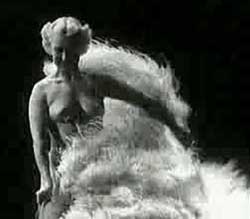 We're down to the last & best act, featuring a great burlesque talent with Carmelita in Her Famous Fan-Ny Dance.
We're down to the last & best act, featuring a great burlesque talent with Carmelita in Her Famous Fan-Ny Dance.
She even has better music than the other gals, who mostly had nondescript stuff. Carmelita dances to a gentle violin.
Carmelita was one of many Sally Rand-influenced dancers on the burlesque circuit, but other than Noel Toy, few were thought of as more than imitators.
Yet even Sally Rand borrowed her act from a Harlem beauty. Cab Calloway wrote "The Lady With the Fan" in 1933 for Amy Spencer, the Cotton Club fan-dancer celebrated in Cab Calloway's Hi De Ho (1934).
Strutting about with two enormous white feathered fans, & looking like the world's sexiest ostritch against a pitch-black background, we get a glimpse of a fine practitioner of the peek-a-boo fans in Carmelita in her Famous Fan-Ny Dance (1950s).
Carmelita is about as daring as the fan-dance gets on film. She's genuinely talented & her dance movements have an art deco beauty.
At only a little over a minute long it's definitely too short. It ends with a text sign that says "That's All For now, Boys. Come back tomorrow. Maybe her fans will slip!" As if the film might end differently next time someone plunked their money in the slot.
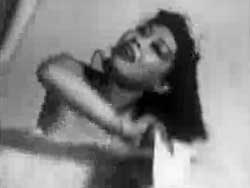 Noel Toy (nee Ngun Yee) was born in San Francisco of Cantonize immigrants. She stars in a very artful arcade loop film Chinese Joy Dance (circa 1944).
Noel Toy (nee Ngun Yee) was born in San Francisco of Cantonize immigrants. She stars in a very artful arcade loop film Chinese Joy Dance (circa 1944).
This is quite a surprising thing to encounter, as a three minute burlesque movie which has been categorized as a "soundie" rather than a stag film by a few who've noticed it's awfully well done. Although "dancie" might be more apropos.
It was initially made by the obscure Wellmar Films studio for "adults only" panoram visual jukebox play, but ended up on the 8 mm & 16 mm home projection market.
 Noel Toy was a fan-dancer & quite talented. She played the American burlesque circuit "coast to coast" says the voice-over narrator at the beginning. The narrator notes she was in particular a star of the New Follies Bogiere' in New York. Noel Toy was a fan-dancer & quite talented. She played the American burlesque circuit "coast to coast" says the voice-over narrator at the beginning. The narrator notes she was in particular a star of the New Follies Bogiere' in New York.
Unsaid is how she began her career in a San Francisco club called The Forbidden City, the biggest & most famous in Chinatown. She also starred in New York's most famous risque niteclubs such as Maxie's, The 18th Club, The Latin Quarter, & Stork Club.
Modern feminists may find her reliance on the objectification of women's bodies for her income to be unacceptible, in which attitude they will find easy company with far-right-wing fundamentalists who think of feminists & strippers as the same kind of godless sinners. But Noel was in fact an early feminist activist who publically criticized the popular stereotype of Chinese women as submissive & subservient.
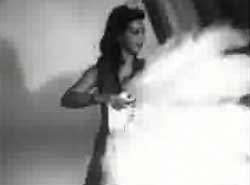 In Chinese Joy Dance she's wearing a sort of fluffy bikini bottom to keep the film from being actionable by law, but is completely topless, & not especially concerned with how often one sees behind the fans. In Chinese Joy Dance she's wearing a sort of fluffy bikini bottom to keep the film from being actionable by law, but is completely topless, & not especially concerned with how often one sees behind the fans.
She's a beautiful woman & a talented dancer, regarded in her day as tastefully erotic, performing for a mixed clientelle in pretty nice clubs.
She was sometimes billed as "the Chinese Sally Rand," as Rand was generally regarded as the last super-star of the fan-dance. Noel also danced with a huge balloon, pretty much copying Sally Rand's two most famous dances (see my reviews of Sally's two panoram movies The Bubble Dance & The Fan Dance, both 1942).
She married character actor Carleton Young & retired from exotic dancing at his request, but continued to pursue an acting career. She has bit parts in a number of good movies, although Hollywood alas was not blind to race. If you watch carefully you will glimpse her in films starring such leading lights as Clark Gable, Debra Paget, Gene Tierney, Betty Grable or Humphrey Bogart.
copyright © by Paghat the Ratgirl
|
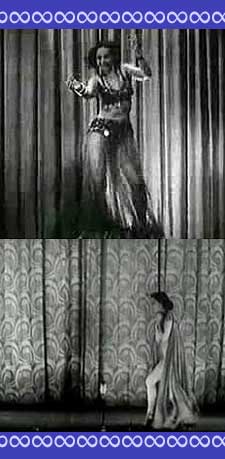




 Ginger Britton struts around with enough clothes on to appease a Muslim cleric, but immediately sheds one layer. Other girls stand in semi-undress or behind gauzy cloth on the top of pedistals & a staircase, but don't much move.
Ginger Britton struts around with enough clothes on to appease a Muslim cleric, but immediately sheds one layer. Other girls stand in semi-undress or behind gauzy cloth on the top of pedistals & a staircase, but don't much move.



 It concludes with her showing her breasts full front, so the customers sure wouldn't be complaining, given that so many such films did the tease only, not the reveal.
It concludes with her showing her breasts full front, so the customers sure wouldn't be complaining, given that so many such films did the tease only, not the reveal.


 Noel Toy was a fan-dancer & quite talented. She played the American burlesque circuit "coast to coast" says the voice-over narrator at the beginning. The narrator notes she was in particular a star of the New Follies Bogiere' in New York.
Noel Toy was a fan-dancer & quite talented. She played the American burlesque circuit "coast to coast" says the voice-over narrator at the beginning. The narrator notes she was in particular a star of the New Follies Bogiere' in New York. In Chinese Joy Dance she's wearing a sort of fluffy bikini bottom to keep the film from being actionable by law, but is completely topless, & not especially concerned with how often one sees behind the fans.
In Chinese Joy Dance she's wearing a sort of fluffy bikini bottom to keep the film from being actionable by law, but is completely topless, & not especially concerned with how often one sees behind the fans.